Chapter 6
Discovering the Best Free Windows Add-Ons
IN THIS CHAPTER
![]() Finding out which Windows apps you must have
Finding out which Windows apps you must have
![]() Getting the lowdown on the best of free apps
Getting the lowdown on the best of free apps
![]() Figuring out what software you don’t need
Figuring out what software you don’t need
Much as I like Windows 11, it has a few glaring holes that can be fixed only by non-Microsoft software. For example, playing video files with the Movies & TV app works well, but it doesn’t hold a candle to VLC Media Player. That’s why, in this chapter, I step you through two different kinds of software. First come the (few) programs you need to fix holes in Windows. Second is a much larger group of programs that just make Windows work better. Both collections have one thing in common: They’re free for personal use.
At the end of this chapter, I turn to one of my favorite topics: Software that you don’t need and should never pay one cent to acquire. Lots of snake oil salespeople are out there. This chapter tells you why they’re just blowing smoke.
Windows Apps You Absolutely Must Have
Depending on what kind of Windows 11 machine you have, there’s a short and sweet list of free software you need.
VLC Media Player
Although Microsoft made a few minor improvements to its media handling in Windows 11 — adding the capability to play FLAC lossless audio, MKV video, and a handful of less interesting media formats — it remains woefully underpowered in its capability to work with common media files.
Unfortunately, some brand-spanking new Windows 11 PCs won’t play DVD movies. Why? Microsoft decided that, even though it shipped the DVD-playing capability in previous versions of Windows, putting that capability in Windows 8 and later just cost too much. You can read the details at www.infoworld.com/article/2616896/microsoft-windows/update--windows-8-won-t-be-able-to-play-dvds.html.
Most PC makers step in and provide DVD and Blu-Ray movie-playing software with their new machines, but they’re under no obligation to do so. That’s why I suggest you get a DVD movie and use the free VLC Media Player program. In fact, VLC is so good that I use it and recommend it for all media playing — music and movies. VLC includes the small translation programs (called codecs) that let you play just about any kind of music or video on your Windows 11 PC.
Unlike other media players, VLC sports simple controls; built-in codecs for almost every file type imaginable; and a large, vocal online support community. VLC plays internet-streaming media with a click, records played media, converts between file types, and even supports individual-frame screen shots. VLC is well-known for tolerating incomplete or damaged media files. It will even start to play downloaded media before the download is finished.
Hop over to VLC (www.videolan.org) and install it (see Figure 6-1). Yeah, it looks spartan, but it works very well indeed.
VLC has played with the idea of shipping a Windows 11 app version of VLC but results as of this writing are disappointing. Unless you’re running Windows 11 in S mode — and thus can’t run programs on the desktop — I’d give the Microsoft Store version a pass.

FIGURE 6-1: VLC Media Player plays every song and video type imaginable, even your video DVDs.
Bitwarden
In Book 9, Chapter 4, I talk about two password managers, Bitwarden and RoboForm. Both are excellent choices. Most people, in my experience, prefer Bitwarden, but you ought to look at Book 9, Chapter 4 and see if your circumstances are different. I use Bitwarden in all my browsers and on all my computers and devices: Windows, Android, iOS, Chrome OS, Mac, you name it.
Bitwarden (shown in Figure 6-2) keeps track of your user IDs, passwords, and other settings, stores them in the cloud, and offers them to you with a click. Bitwarden does its AES-256 encrypting and decrypting on your PC, using a master password that you must remember. The data that gets stored in the cloud is encrypted, and without the key, the stored passwords can’t be broken, unless you know somebody who can crack AES-256 encryption.
Bitwarden works as a browser add-on for Microsoft Edge (see Figure 6-2), Mozilla Firefox, and Google Chrome, so all your passwords are stored in one place, accessible to any PC you happen to be using — if you have the master password.
Bitwarden is free for personal use. The Premium version, which adds two-step login options and other useful features, costs $10 a year.
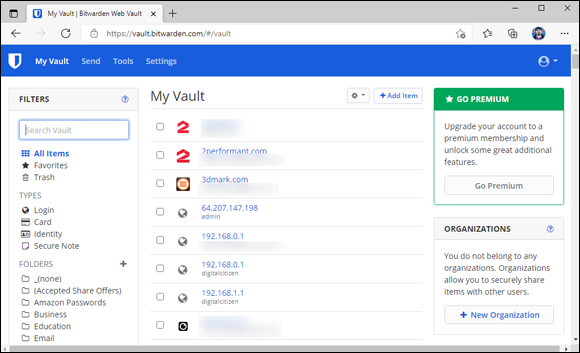
FIGURE 6-2: Bitwarden gives you one place to store all your passwords — and all the encrypting is done on your computer.
Recuva
Deleted files recovery has been a mainstay PC utility since forever. But there’s never been an undeleter better than Recuva, which is fast, thorough, and free. See Figure 6-3.
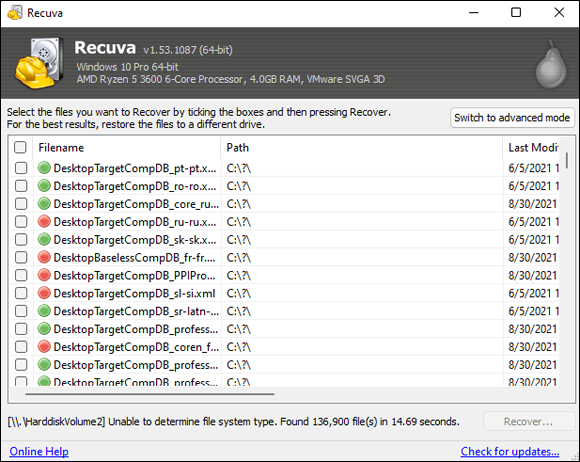
FIGURE 6-3: Recuva undeletes files — even on your smartphone.
When you throw out the Recycle Bin trash, the files aren’t destroyed; rather, the space they occupy is earmarked for new data. Undelete routines scan the flotsam and jetsam and put the pieces back together.
As long as you haven’t added new data to a drive, undelete (almost) always works. If you’ve added some data, there’s still a good chance that you can get most of the deleted stuff back.
Recuva can also be used to recover data on a USB drive, an SD card, and many smartphones and digital cameras that can be attached to your PC.
Powerful stuff. For more advanced features, there’s a Pro version for about $20.
The Best of the Rest — All Free
Here are my recommendations for useful software that you may or may not want, depending on your circumstances. Hey, the price is right.
Ninite
Leading the list of traditional desktop programs is one that helps you install (and update) other programs. Actually, it isn’t a program — it’s a website. When you start looking at desktop applications, your first stop should be to https://ninite.com/ (see Figure 6-4). Simply click or tap the applications you want and Ninite will download the latest versions free of crapware, install them, and leave you in the driver’s seat.
Need to update your apps? Run Ninite again. Everything’s brought up to date, no junkware, no hassle. For the full royal treatment — where Ninite notifies you of changes to programs you’ve installed —Ninite Updater ($9.99/year) works like a champ.
The beauty of the Ninite approach is that all these apps are a click away — no fuss, no nags, no charge. It’s the best way I know to install a bunch of good programs on a new machine in just a few minutes. The downside? It misses a few of my favorite desktop apps.
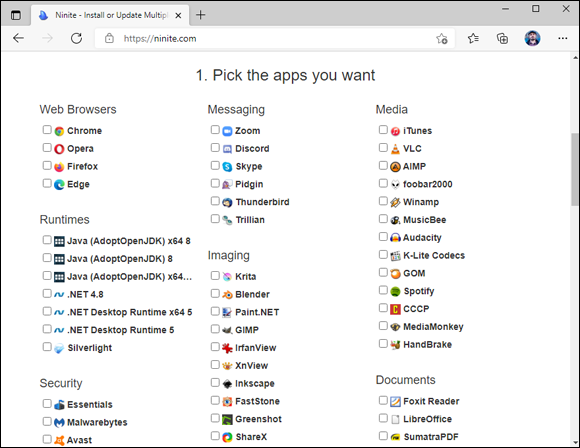
FIGURE 6-4: Install or update popular desktop apps with Ninite.
Revo Uninstaller
Revo Uninstaller (www.revouninstaller.com/revo_uninstaller_free_download.html) well and truly uninstalls programs, and it does so in an unexpected way.
When you use Revo, it runs the program’s uninstaller and watches while the uninstaller works, looking for the location of program files and for registry keys that the uninstaller zaps. It then goes in and removes leftover pieces, based on the locations and keys that the program’s uninstaller took out. Revo also consults its own internal database for commonly left-behind bits and roots those out as well.
Revo gives you a great deal of flexibility in deciding just how much you want to clean and what you want to save. For most programs, the recommended Moderate setting strikes a good balance between zapping problematic pieces and deleting things that really shouldn’t be deleted.
If you uninstall programs — whether to tidy up your system or to get rid of something that’s bothering you — it’s worth its weight in gold.
Paint.NET
In Book 5, Chapter 2, I talk about the Microsoft Paint program, which can help you put together graphics in a pinch. For powerful, easy-to-use photo editing, with layers, plugins, and all sorts of special effects, along with a compact and easily understood interface, I stick with Paint.NET (see Figure 6-5).
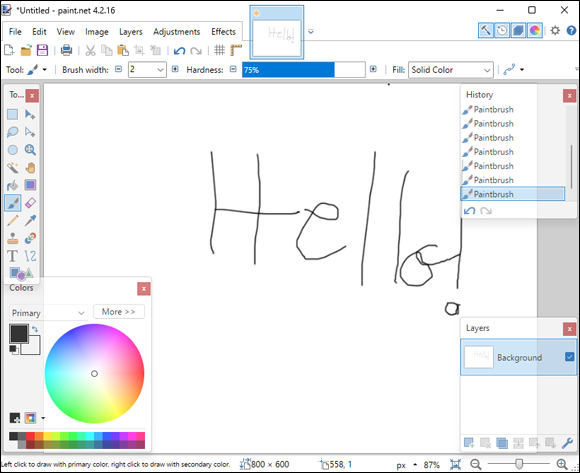
FIGURE 6-5: Paint.NET is a powerful image editor.
The program puts all the editing tools a nonprofessional might reasonably expect into a remarkably intuitive package. Download it at www.getpaint.net and give it a try.
With dozens of good — even great — free image editors around, it’s hard to choose one above the others. IrfanView, for example, has tremendous viewing, organizing, and resizing capabilities, but it is not as versatile at editing like Paint.NET.
7-Zip
Another venerable utility, 7-Zip (www.7-zip.org) still rates as a must-have, even though Windows supports the ZIP format natively. Why? Because some people of the Apple persuasion will send you files in the RAR archive format from time to time, and 7-Zip is the fast, easy, free way to handle them.
7-Zip also creates self-extracting EXE files, which can come in handy (although heaven help you if you ever try to email one — most email scanners won’t let an EXE file through). And it supports AES-256 bit encryption. The interface rates as clunky by modern standards (see Figure 6-6), but it gets the job done with ZIP, RAR, CAB, ARJ, TAR, 7z, and many lesser-known formats. It even lets you extract files from ISO CD images.
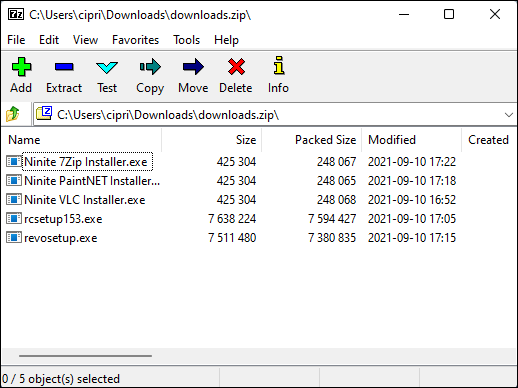
FIGURE 6-6: 7-Zip may not have the greatest interface, but it’s a workhorse.
Another poster boy for the open-source community, 7-Zip goes in easily, never nags, and wouldn’t dream of dropping an unwanted toolbar on your system. Enlightened.
qBittorrent
If you aren’t yet using torrents (a method of distributing files over the internet), now’s the time to start. Torrents have taken a bad rap for spreading illegal, pirate software. Although that reputation is entirely deserved, it’s also true that many torrents are legitimate. And they are the single most efficient way to distribute files online.
For years I’ve used and recommended uTorrent, but the current version’s installer includes crapware — and in previous versions, it has installed some really obnoxious crapware.
Instead, try qBittorrent, shown in Figure 6-7. It’s simple, fast, and easy to use, and it supports magnet links (which simplify downloads), with extensive bandwidth reporting and management. Download it at www.qbittorrent.org.
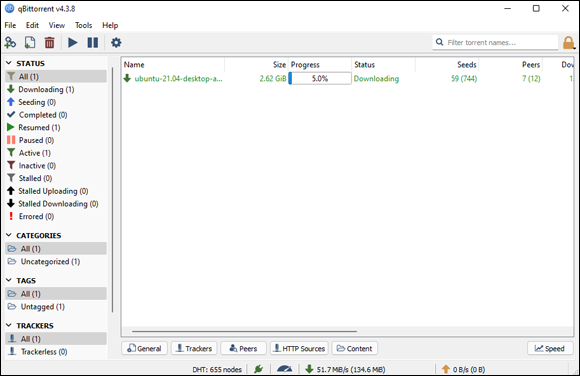
FIGURE 6-7: qBittorrent doesn’t have uTorrent’s baggage.
Dropbox, Google Drive, OneDrive, or …
Even if the thought of putting your data on the internet drives you nuts, sooner or later you’re going to want a way to store data away from your main machine, and you’re going to want an easy way to share data with other people or other devices (desktops, laptops, tablets, and smartphones).
There’s no obvious winner — no cloud storage that’s inherently better than any of the others. Just pick one and get it set up. Someday, it’ll save your tail. I used Dropbox for the files for this book. I also use OneDrive for most of my personal files, and Google Drive for my blogging work at Digital Citizen.
They all have free introductory options, and some give you an enormous amount of storage for free or for a small fee. Some even provide a large amount of storage if you subscribe to a related service such as the Microsoft 365 subscription. Simply take a look at their plans (see Figure 6-8) and choose the one you consider best.

FIGURE 6-8: Check the plans available for Dropbox, OneDrive (Microsoft 365), and Google Drive.
Other interesting free software
If you connect over public Wi-Fi, such as in a coffee shop, you should use a Virtual Private Network (VPN). I talk about VPNs in Book 9, Chapter 4. Session hijacking, pioneered by the program Firesheep, can let others pose as you, even while your session is in progress. Using secure sockets (SSL) helps, but even those can be subverted in certain circumstances. Your best bet is to stick with VPN.
Wonder what programs run whenever you start Windows? Look at Microsoft’s venerable and free-as-a-breeze Autoruns at https://technet.microsoft.com/en-us/sysinternals. Autoruns finds more autostarting programs (add-ins, drivers, codecs, gadgets, shell extensions, whatever) in more obscure places than any other program, anywhere. Autoruns not only lists the autorunning programs but also lets you turn off individual programs. It has many minor features, including the capability to filter out Microsoft-signed programs, a quick way to jump to folders holding autostarting programs, and a command-line version that lets you display file hashes. Autoruns doesn’t require installation. It’s a program that runs and collects its information, displays it (using a rudimentary user interface), lets you wrangle with your system, and then fades away.
You may not need to buy Microsoft Office
If your needs are simple and you don’t have to edit fancy documents created in Word, Excel, or PowerPoint, you may be able to get by with Google apps (which I discuss in Chapter 4 of this minibook) or LibreOffice. The web-based Office Online apps are also good — and free for personal use. If you’re moonlighting with a Mac, the iWork apps might do, too.
The big advantage to Microsoft 365: You get not only six licenses of the latest versions of the Office programs — Word, Excel, PowerPoint, Outlook, OneNote, Access, Publisher — for PCs or Macs, but also licenses for five tablets (including Office for iPad, which is a tremendous product), and five licenses for phones (largely forgettable). In addition, you get 1TB of OneDrive online storage per user for up to six users. Unless you have a visceral reaction to renting Office — I can sympathize — Microsoft 365 at $100/year or less comes across as a bargain.
Whenever somebody asks me, “Why do you recommend Office when OpenOffice/LibreOffice does everything for free?” I have to cringe. It’s true that Microsoft Office is expensive, and with Microsoft 365 you’re locked into the annual fee. It’s also true that good, but not great, alternatives exist — including Google Workspace (which I discuss in Chapter 4 of this minibook).
Here are two substantial problems:
- As much as I would love to recommend a free replacement for Word, Excel, or PowerPoint, the simple fact is that the free alternatives (other than Office Online) aren’t 100 percent compatible. In fact, for anything except the simplest formatting and most basic features, they aren’t compatible at all. Even Microsoft’s free Office Online Apps aren’t as full-featured as the real Word, Excel, and PowerPoint. If your needs are modest, by all means, explore the alternatives. But if you have to edit a document that somebody else is going to use and it has any unusual formatting, you may end up with an unusable mess.
- Many people don’t realize it, but OpenOffice.org isn’t the same organization it used to be. In fact, there’s an ongoing debate about the superiority of the new OpenOffice.org (which now belongs to Apache) and the renegade offshoot LibreOffice (
www.libreoffice.org). Basically, some feel that OpenOffice.org moved away from its open-source roots when Oracle owned it, so a new organization, LibreOffice, forked the code (made a copy of the original code and then improved it) and released several new versions that are not associated with OpenOffice.org or Oracle. So you’re left with two organizations, slightly different products, and no clear indication of which version (if either) will be around for the long term.
Don’t Pay for Software You Don’t Need!
If you’ve moved to Windows 11, there’s a raft of software — entire categories of software — that you simply don’t need. Why pay for any of it?
Many people write to ask me for recommendations about antivirus software, utility programs, registry cleaners, or backup programs. The simple fact is, if you've moved up to Windows 11, you don’t need lots of this stuff.
In this, the last section of the last chapter of this book, I’m going to lay it on the line — point out what you don’t need, in my considered opinion — and try to save you a bunch of money. With any luck, the following handful of tips will save you the price of the book.
Windows 11 has all the antivirus software you need
Windows Security includes Microsoft Defender Antivirus, formerly known as Windows Defender. It works great and doesn’t cost a cent. If you follow the recommendations in this book, you don’t need to pay a penny for antivirus, antispyware, anti-anything software, and you don’t need a fancy outbound firewall, either. (I talk about Windows Security and Windows Defender Firewall in Book 9, Chapter 3.)
You do need other security programs, however. I list those in Book 9, Chapter 4. They’re free.
Windows 11 doesn’t need a disk defragger
Because of the way Windows stores data on a hard drive and reclaims the areas left behind when deleting data, your drives can start to look like a patchwork quilt, with data scattered all over the place. Defragmentation reorganizes the data, plucking data off the drive and putting files back together again, ostensibly to speed up hard drive access.
It’s true that horribly fragmented hard drives — many of them handcrafted by defrag software companies trying to prove their worth — run more slowly than defragged drives. However, in practice, the differences aren’t that remarkable, particularly if you defrag your hard drives every month or two or six. (Note that you should never defrag a solid-state drive.) Even moderately bad fragmentation doesn’t make a noticeable difference in performance, although running a defrag every now and again helps.
With Windows 11, you don’t need to run a defrag. Ever. If you have a solid-state drive, you don’t need (or want) a defrag — it wears out your drive and doesn’t improve anything. If you have a whirling-platter hard drive, Windows runs a defrag for you, by default, one day every week.
Windows 11 doesn’t need a disk partitioner
I hate disk partitioning, but rather than get into a technical argument (yes, I know that dual-boot systems with a single hard drive need multiple partitions), I will limit myself to extolling the virtues of Windows 11’s partition manager.
No, Windows 11's disk partition manager isn't a full-fledged program, but it does everything with partitions that most people need — and it gets the job done without messing up your hard drive. That's more than I can say for some third-party disk partition managers.
To run Windows 11's built-in disk partitioner, type partition in the Windows 11 Search box. Click or tap Create and Format Hard Disk Partitions, which should be the first link. That displays the Disk Management program (see Figure 6-9), where it's right-click easy to see, delete, expand, and change your partitions.
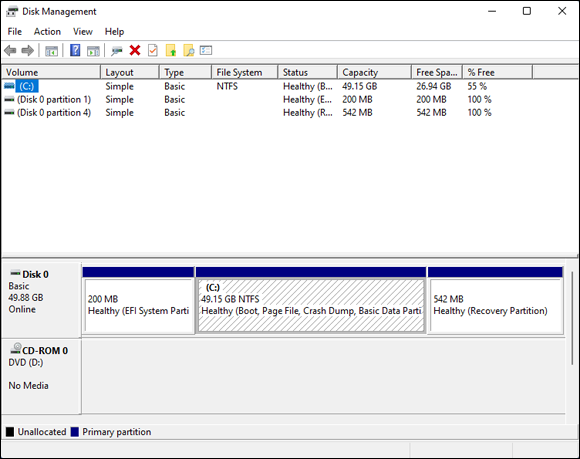
FIGURE 6-9: The Disk Management program enables you to manage your partitions with ease.
If you want to create a partition, right-click or press and hold down on any empty area and choose Create Volume. If you want to make a new partition on a volume that's full, right-click or press and hold down on the volume and choose Shrink Volume.
Windows 11 doesn’t need a registry cleaner
I’ve never seen a real-world example of a Windows machine that improved in any significant way after running a registry cleaner. As with defraggers, registry cleaners may have served a useful purpose for Windows XP, but I think they’re useless nowadays. I’ve never found a single run of a single registry cleaner that caused anything but grief.
A great quote originated (as best I can tell) on the DSLReports forum in March 2005. A poster who goes by the handle Jabarnut stated, “The Registry is an enormous database, and all this cleaning really doesn’t amount to much … I’ve said this before, but I liken it to sweeping out one parking space in a parking lot the size of Montana.” And that’s the long and short of it.
Jabarnut is correct: The registry is a giant database — a particularly simple one. As with all big databases, sooner or later some of the entries get stale; they refer to programs that have been deleted from the system or to settings for obsolete versions of programs. Sure, you can go in and clean up the pointers that lead nowhere, but why bother? Registry cleaners are notorious for messing up systems by cleaning things that shouldn’t be touched.
Windows 11 doesn’t need a backup program
The File History backup option, which I discuss at length in Book 8, Chapter 1, works very well. The only possible exception is if you’re paranoid enough to want a full ghost backup of your hard drive. In that case, yes, you have to acquire (possibly buy) a backup program. But why bother? Windows 11’s tools work very well indeed.
Don’t turn off services or hack your registry
I just love it when people write to me, all excited because they've found a Windows service that they can turn off with no apparent ill effect. Other people tell me about this neat Windows pre-fetch hack they’ve found, in which a couple of flipped bits in the registry can significantly speed up their computer. Before the change, Windows boot times were so slow. Now, with the hack, it’s like having a new PC all over again!
I call this the Registry Placebo Effect. If you find an article or a book or a YouTube video that shows you how to reach into the bowels of Windows to change something, and the article (or book or video) says that this change makes your machine run faster, well — by golly — when you try it, your machine runs faster! I mean, just try it for yourself: Your machine will run so much better.
Yeah. Sure. Once upon a time in the early days of Windows, turning off a few services (little Windows background programs that run automatically every time you boot) may have added a minor performance boost to your daily Windows ME routine. Bob may have jumped up faster, or Clippy could have offered his helpful admonitions a fraction of a millisecond more quickly. But these days, turning off Windows services is ineffective. Why? The service you turn off may be needed, oh, once every year. If the service isn’t there, your PC may crash or lock up or behave in some strange way. Services are tiny, low-overhead critters. Let them be.
That covers the high points. I hope this chapter alone paid for the book — and the rest is just gravy!

 Find a DVD or Blu-Ray movie somewhere — if you don’t have one, rent one … if you can find a place to rent them now — and stick the disc in your PC. A Windows notification appears, and you can click or tap that notification and play the DVD or Blu-Ray. It ought to be like falling off a log.
Find a DVD or Blu-Ray movie somewhere — if you don’t have one, rent one … if you can find a place to rent them now — and stick the disc in your PC. A Windows notification appears, and you can click or tap that notification and play the DVD or Blu-Ray. It ought to be like falling off a log. Pay attention when downloading Paint.NET. Unfortunately, its official site displays many intrusive ads. Make sure to close them all, and don’t get tricked into downloading something else. If you want a simpler download process, try this location instead:
Pay attention when downloading Paint.NET. Unfortunately, its official site displays many intrusive ads. Make sure to close them all, and don’t get tricked into downloading something else. If you want a simpler download process, try this location instead: